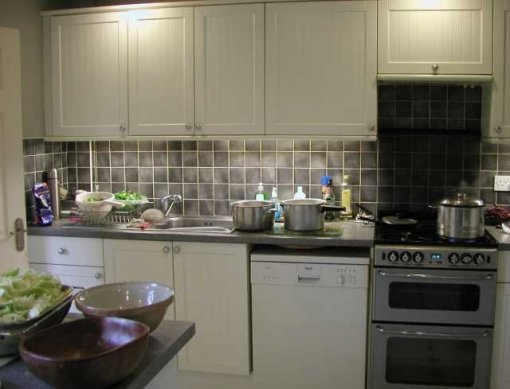Having been busy harvesting, Monday was food processing day. The first thing was the French beans and runner beans. We’d got a carrier bag full of runners and half a bag of French to freeze.
Then we had some sweet peppers and a cabbage that had some unwelcome guests (slugs) munching away in it and finally 30 odd cobs of sweetcorn. We’d harvested 40 but given ten away. There’s probably another 40 nearly ripe on the plants.
By now we have this down to a fine art. Val prepares and I do the blanching. Blanching seems to be a bit of a mystery to some people but it is really simple. The idea is to bring whatever you want to freeze up to the boil for a short period and then to stop the cooking process and cool the food as quickly as possible.
Use a large pan on the cooker and bring it up to a vigorous boil. The reason for a large pan is that the heat held in the water gets the food up to the boil faster. This is important for best results. You don’t want the food to go mushy by slowly raising the temperature.
When bringing the water to the boil and blanching, I always use a lid on the pan. You’ll be amazed how much faster a saucepan boils with a lid on. It also means less steam filling the kitchen.
Once the food has been blanched for the appropriate time, it comes out of the boiling water and gets dropped into the first large pan of cold water. Whilst it is cooling down, the next load to blanch gets put into the blanching basket and back into the boiling water. A blanching basket, by the way, is just like an old fashioned chip pan basket.
Then back to the cold pan and using a sieve, the cooling food is transferred from the first pan, which now has warmish water in, to the second cold water pan. Then change the water in the first cold pan so it is cold again.
A minute or two’s break and we start again. From the boiling pan to the first cold pan, thence to the second and then to a colander to drain. Finally into the fridge to carry on bring the temperature down.
When the batch is finished and cooled in the fridge, bag up and into the fast-freeze bit of the freezer. It’s a good idea to pop the ‘super freeze’ button on the freezer an hour or two before you start. This ensures the freezer is a cold as possible before you start warming it up by adding relatively warm food.
The ideal temperature is minus 20 deg C for your freezer. You need a freezer with the 4 star rating. This not only holds below minus 18 deg C but also will freeze. Some fridge / freezers only have 3 stars or less and are not suitable for freezing or long term storage.
The most efficient freezer for storing large amounts is a chest freezer. They use less energy for the volume and lose less chilled air when you open them. On the other hand, things do have a tendency to end up at the bottom, never to be found.
There’s an article on freezing and blanching on the site along with a blanching time chart. How to Freeze Vegetables
The boiling pan is on the right, on the largest ring on the cooker. Then the two cooling pans by the sink and the colanders draining on the left.





Shame about the cabbages there John! I thought you used slug deterrents?
I have used your blanching tips with great success and thank Val for her Jam recipes. Its great eating strawberry and summer fruit jams
Although there is no substitute for the fresh cabbages, French beans and caulis as they do lose that bite a little in my opinion. They worked pretty well but the broad beans were like they had just been podded.
Rgds,
Cazaux
I do use some slug pellets (the safe type) but I try and minimise my use of them. I don’t claim to be organic, but I go for minimum input. Anyway, if it ain’t good enough for the bugs, it ain’t good enough for us!
Totally agree re the blanching. Val’s strawberry conserve is just wonderful. Honestly, I’ve never tasted shop bought half as good.